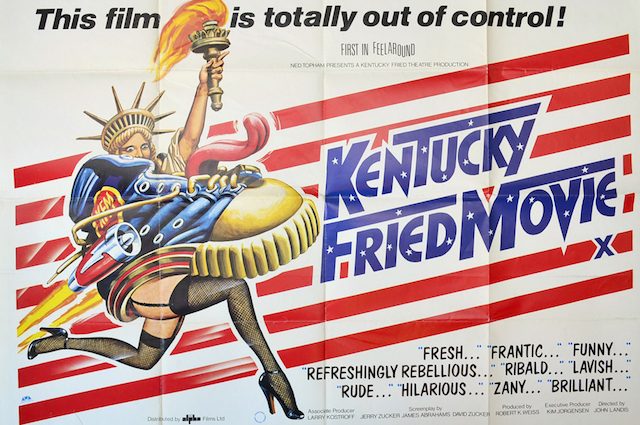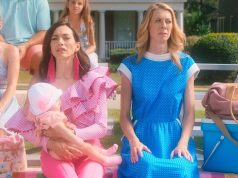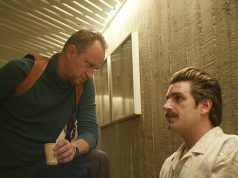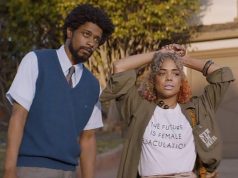
Sketch comedy has been a staple of television ever since TV emerged, fully formed, from Milton Berle’s nurturing womb, but it’s never been a big hit in the movie world. Something about the format of brief, unrelated comic scenarios without an ongoing storyline just isn’t as appealing at the cinema as it is in the coziness of your own home. Maybe it’s the same reason anthologies are rarely box-office hits: moviegoers are usually in the mood for a single, full-length experience, not a bunch of short ones. It’s just how we’re wired.
Yet despite being a small sub-genre with only a handful of entries, the sketch-comedy movie has been curiously influential. Monty Python’s “And Now for Something Completely Different” (1971) helped introduce the troupe to U.S. audiences before “Flying Circus” began airing on American TV, and the group’s subsequent all-sketch feature, “The Meaning of Life” (1983), is still a much-quoted gem. Woody Allen’s “Everything You Always Wanted to Know About Sex* (*But Were Afraid to Ask)” (1972) was a smash, and it came early enough in his career to provide an important boost to his momentum. “The Groove Tube” (1974), a raunchy spoof of TV and counterculture, is all but forgotten now and got bad reviews at the time — but it made $20 million (in 1974 money!) and helped an unknown cast member named Chevy Chase get a gig on “Saturday Night Live” a year later.
But perhaps the most influential sketch-comedy movie — or at the very least the one that this article is about — is “Kentucky Fried Movie” (1977). This was the first film collaboration of writer/performers David Zucker, Jerry Zucker, and Jim Abrahams, the trio later responsible for such zany classics as “Airplane!,” “Top Secret!,” “Police Squad,” and “The Naked Gun.” Look, I don’t care who are you, that stuff is funny. Not every joke, not every scene, but most of it works, a ridiculously high batting average for a team that always swung for the fences. The ZAZ team’s spoof output from 1977 to 1994 (we’ll stop at the last “Naked Gun” movie) was a distinctive chapter in comedy history, its absurd mixture of everything from highbrow wordplay to pie-in-the-face slapstick the closest thing there’s been to a live-action MAD Magazine. A whole generation of TV and film writers grew up watching, quoting, and internalizing the ZAZ humor style, and you see it reflected in free-form absurdist-leaning comedies like “30 Rock” and “Childrens Hospital.”
And it all started with “Kentucky Fried Movie.” It was just released on Blu-ray, which means it’s sharing the shelves with two of its inferior descendants: “Movie 43” and “InAPPropriate Comedy,” both of which played in theaters in 2013 and were huge critical and commercial disasters. By comparing the three, perhaps we can learn something about how comedy has changed over the years, or at least find an excuse to say “boobs” a lot.
* * *
“Kentucky Fried Movie” is structured almost entirely as a series of TV, commercial, and movie spoofs. What few sketches are set in “real life” are about people watching TV or going to movies; most are parodies of the things they see. “Film and TV” is a broad concept, but a concept nonetheless. Sometimes the association is loose. “Courtroom,” presented as a black-and-white legal drama from the ’50s, doesn’t parody the conventions of the genre — it’s really just an excuse for a very funny sketch set in a courtroom. Other segments, like the ongoing TV news bits, are more directly “about” their formats.
“InAPPropriate Comedy” has the same type of structure as “KFM.” Here a creepy man who lives in a sewer clicks a series of apps on his iPad, each one leading to a sketch, each sketch being a TV or movie parody. But while “KFM” mostly spoofed generalities — types of movies, types of commercials — “InAPPropriate Comedy” goes for specifics, at least in name. “Blackass” is “Jackass” but with black guys. “The Amazing Racist” is about a guy who goes around being a racist. “Flirty Harry” has Adrian Brody as a flamboyant Dirty Harry. “Go ahead,” he says. “Make me gay.” Yes, that’s as funny as it gets.
Unlike its fellows, “Movie 43″ hardly even bothers with a structure. It has a lackluster wraparound story — a desperate writer (Dennis Quaid) tries to get a Hollywood producer (Greg Kinnear) to buy his screenplay — but the sketches are unconnected comedy bits with straightforward premises. Few of them are satirical; instead of poking fun at something, most simply find a humorous situation and put it to work making the yuk-yuks.
You could see any of these being performed live by Second City or The Groundlings or your college comedy troupe. A woman goes on a blind date with a man whose testicles are on his neck, and she is the only one who seems to notice. Two parents home-school their son and go all the way with creating a school atmosphere, complete with bullying and dating. (“It should be the unhappiest time in a teenager’s life!”) Robin the Boy Wonder tries speed-dating and is constantly interrupted by an obnoxious Batman. A man and woman are in love, and what she wants most of all as an expression of their everlasting commitment is for him to poop on her. And so on.
“Movie 43″ is also different from nearly every other sketch-comedy film in that its segments were all written and directed by different people, with no connection to one another. What consistency there is in tone and style is primarily coincidental. Several sketches happen to involve dating, for example, but there’s no larger theme. “Kentucky Fried Movie” hits a lot of subjects, but everything has the ZAZ imprint. You can find it in dialogue like this, from the “Courtroom” sketch:
LAWYER: Mr. Grunwald, would you kindly tell the court the fabric of which your shirt is made?
OTHER LAWYER: I object, your honor, that shirt is immaterial.
The longest segment, a 32-minute kung fu parody called “A Fistful of Yen,” is a miniaturized version of the feature-length spoofs that ZAZ were yearning to make. Overall, it’s the weakest part of the film — they would get better at maintaining a plot without sacrificing humor — but it has its moments, like the three Chinese bodyguards named Hung Well, Long Wang, and Enormous Genitals.
“InAPPropriate Comedy” is also the product of a single vision. Unfortunately, that vision belongs to Vince Offer, who’s best known as the ShamWow pitchman and who should be prevented, through legislative action if necessary, from ever making another film. He made a similar one, “The Underground Comedy Movie,” back in the ’90s, and I have every reason to believe it’s as excruciating as “InAPPropriate Comedy.” (Ugh, even the title makes me want to stab myself.)
* * *
Vince Offer’s problem, not to put too fine a point on it, is that he doesn’t know what comedy is. I mean, he probably laughs at things he finds funny, like the rest of us. So he’s aware that “comedy” is a “thing.” But what he and co-writers Ken Pringle and Ari Shaffir offer up in “InAPPropriate Comedy” is a punishing series of scenes that barely have comedic premises, let alone humorous execution.
For example, the joke — the only joke — of “Flirty Harry” is that he’s gay, and so everything he says comes out as a double entendre. But it’s contrived, awkward double entendre, stuff nobody would ever say except as double entendre. “I told you before, I am not gonna wait around for a bunch of other dicks [cops, I guess?], not when I have an opening to take those guys from the rear!… Sir, I know this is a heavy load. I realize I’m leaving you with a mess all over your face.” You get the idea.
“The Amazing Racist” is a great title for a sketch, maybe a parody of reality TV where people compete to see who’s the best (worst?) racist. What Offer does with it, though, is a conceptual muddle. The title character (played by co-writer Shaffir) goes around “Borat”-style doing outrageously racist things in public. He offers black people on a beach a boat ride “back to Africa,” and sets up a driving school specifically for Asians. But the filmmakers don’t realize that the reason hidden camera pranks are funny is that they involve real people who aren’t in on the joke. These are actors, performing scripted outrage. It’s pointless.
What’s more, the racism doesn’t come across as an exaggerated parody of racism. It just comes across as … well, racism. It’s cringeworthy — not, as in “Borat” or “Jackass,” because we feel embarrassed for the people being duped, but because the jokes are mean and unfunny.
Even the parts of “InAPPropriate Comedy” that aren’t about racism find ways to be racist. In one segment, Rob Schneider and Michelle Rodriguez play the porn-reviewing equivalent of Siskel and Ebert. Their current subject is a Japanese flick dubbed into English in which the woman says, “F*** me, Mr. Miyagi! Put it in there, Bruce Lee!” and the guy begs her, “Tell me I’m good at math!” The “Blackass” segments all revolve around black men having large penises, being on welfare, selling drugs, and generally being terrifying. You never get the sense that Offer’s goal is to ridicule such attitudes, only to participate in them.
“Movie 43″ is as crude and vulgar as “InAPPropriate Comedy,” but creatively so, and without the racism. I won’t claim it’s a great film, but it made me laugh more than I expected it to. Part of this comes from the commitment level of every cast member. The testicles-on-the-neck sketch stars Hugh Jackman and Kate Winslet, both as fully invested in the reality of the scene as they are in their serious movies. The homeschooling parents are Liev Schreiber and Naomi Watts, both playing it completely straight. A crucial element in any comedy sketch is how well you “sell” it, and everyone in “Movie 43″ is selling it 100 percent.
The same goes for “Kentucky Fried Movie,” which also benefits from better writing and a clearer sense of purpose. For a 34-year-old comedy, it has surprisingly few dated references. Most of the gags are timeless, like the PSA about death: “In the past year, over 800,000 Americans have died. Despite millions of dollars of research, death continues to be our nation’s number one killer. Hello, I’m Henry Gibson.” (By the way, the symptoms of death include “rigor mortis,” “a rotting smell,” and “occasional drowsiness.”) There’s a commercial for a JFK-conspiracy-themed family board game called Scot-Free (“You’ve just assassinated the president. Can you get away scot-free?”). The trailer for a soft-core nudie flick called “Catholic High School Girls in Trouble” has the tagline “Never before has the beauty of the sensual act been so crassly exploited!” The morning-show newscaster reading the daily horoscopes tells Pisces “it’s a good time to pull the plug on that machine that’s been keeping your daughter alive for the past six months.”
All three films are short. “Movie 43″ is 94 minutes; the other two are both 83. (This may be the only principle of comedy that Vince Offer understands.) All three are rated R, too, and take delight in their freedom. With “InAPPropriate Comedy,” though, there’s an overwhelming sense of desperation in it: they’re being crass because they can’t think of anything else. “Movie 43″ is even filthier, yet the filthiness is rarely gratuitous because it’s in the service of comedy premises that require it. The coarseness is earned, not forced.
“Kentucky Fried Movie” has the best attitude of all. It has no problem going for the dirty joke if it’s there, but it doesn’t stretch for it. These guys knew what they were doing. So do most of the people who made “Movie 43.” (I grant you, one of the directors is Brett Ratner.) Vince Offer the ShamWow guy and his “InAPPropriate Comedy” are proof that sometimes it’s best to leave comedy to the professionals.
— Film.com




